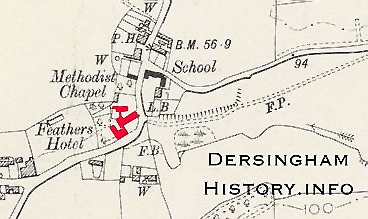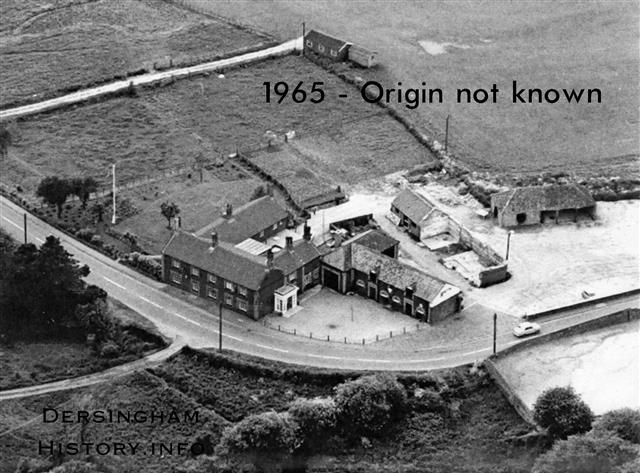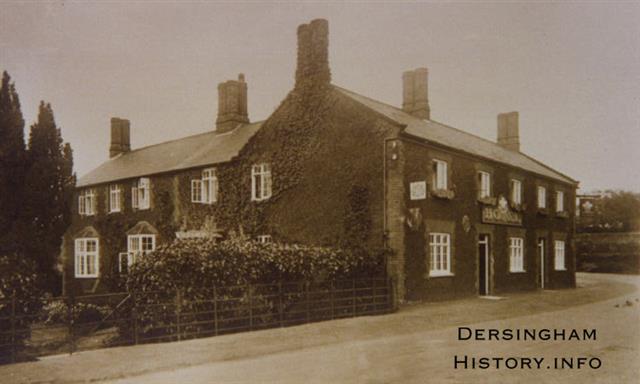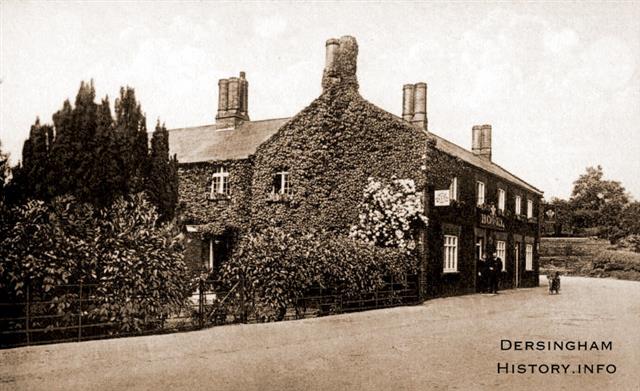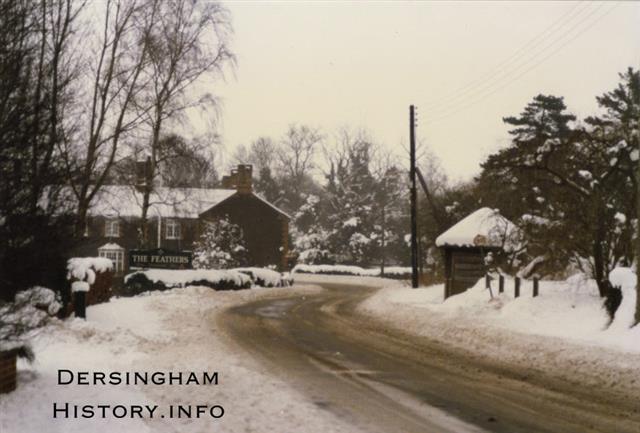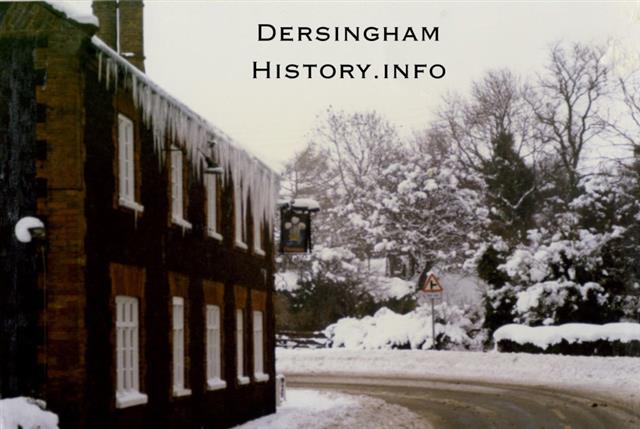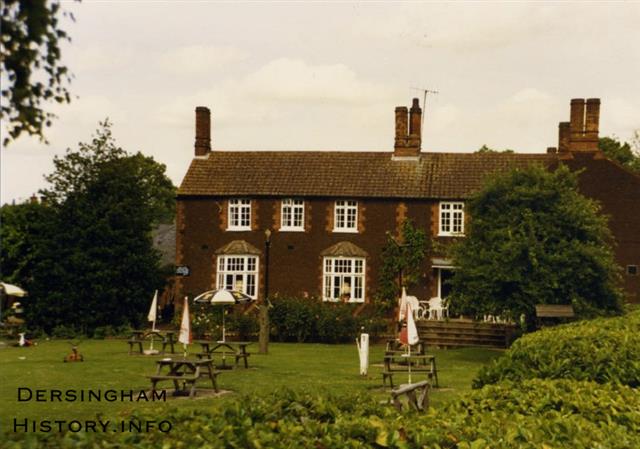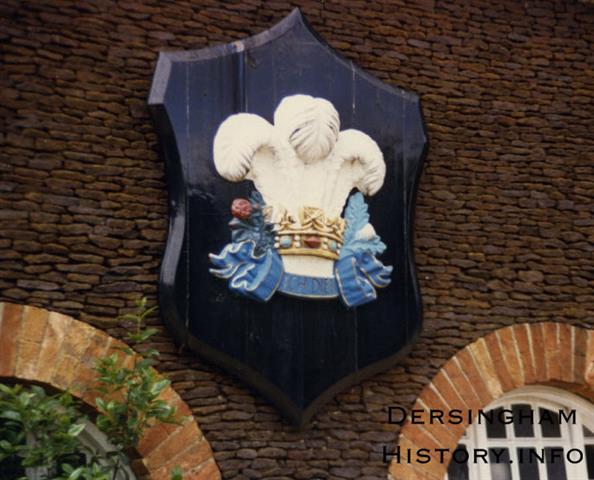The Cock Inn was an important meeting place in the village for centuries and the Royal Archives have numerous mentions of it. The earliest reference they have is in 1844 when Abraham Gay was the tenant. In 1847 when the Hon. Charles Spencer Cowper, the then owner of Sandringham, mortgaged parts of his estate for £5,000 The Cock with accompanying land and cottage in the occupation of one John Wells as a yearly tenant is one of the properties involved. . It is mentioned again in 1861 when a mortgage for £10,500 of the whole estate is taken out. It was purchased as part of the whole estate by the Prince of Wales in 1862. In 1864 it is insured for £300 and is described as “stone and brick built and tiled or slated.” In 1869 it is insured for £250 and is then described as “Dwelling house and Offices known as The Cock Inn Dersingham all attached and occupied by Widow Petrie”
The 1861 census lists The Cock Public House with Archibald Petrie as Innkeeper and farmer of 40 acres. He lives there with his wife Sarah, sister in law Mary Ann Holland and an unnamed lodger who was a drover. Archibald employed a man and two boys to help with the farming. Once a month members of a Friendly Society held their meetings in the Inn. Members were to be between the ages of 18 and 40 and would pay one shilling each month to attend. The Society would then support members financially if they became ill, were unable to work, or in the event of death help towards funeral expenses. Stewards would visit the sick members regularly. Each member paid a shilling a quarter for the doctor to attend any members who were sick once a letter was sent by the clerk. This must have been a great help in the days before the welfare state but there were several strict rules to be followed. Members could be excluded for using bad language, failing to pay their dues, or being found intoxicated. If any were found to be doing any sort of work while receiving sick pay they would be fined for the first offence but excluded if repeating the offence. That reminds me of something I have read about recently! The General Courts Baron of his Royal Highness the Prince of Wales were held at the Inn in 1880 when tenants occupying property on Sandringham land had to attend to pay their Quit rents and perform their suits and services. Sales of property were often held there as well so it was a busy thriving part of the village.
In 1871 Enoch Taylor took over and the Inn is now recorded as The Cock Hotel. Ten years later in 1881 Enoch is still the occupant and is now farming 75 acres employing 3 men and a boy. At the Hotel there are now three domestic servants Kate Morley, Mary Balding and Barbara Bell. Thomas Dent listed as a grocer and draper is a boarder with a John Storer who is a gas fitter. This suggests to me rather bigger premises and we know that sometime about now the little Cock Inn was demolished and the present much larger premises were built. I have read reports that The Cock was badly damaged by fire in the early 1880s and so demolished to make way for the larger premises. It has also been suggested that the new premises were briefly called The Lamb before being renamed The Feathers in honour of the Prince of Wales. I have not yet found any reference to The Lamb but am still trawling through newspaper reports of the time in the hope of finding an account of these events. Certainly by 1883 Enoch Taylor is for the first time recorded as the Proprietor of The Feathers Hotel and Posting House with good stabling for hunters and first class accommodation for visitors. Later (as in the 1896 advertisement seen here) Enoch advertises that conveyances were able to meet any train at Wolferton or Dersingham. Clearly the original Cock Inn is gone and the “pretentious sub-Sandringham building of dark capstone and red brick “as a Houghton report described it was established.
The Feathers remained in Royal ownership until 1932 when it was sold to the people’s Refreshment House Association which had leased the property since 1916 when William Mann, Postmaster at Sandringham, gave it up. This association was formed in 1896 by the Bishop of Chester as he was very concerned about excessive drinking and the abuse of alcohol. The Association paid its hotel managers a fixed salary, but they could make no profit on the sale of alcoholic drinks. They were allowed to make a profit on the sale of tea, coffee, and light refreshments. Although alcoholic drinks were on sale there could be no advertising of the fact although adverts for the sale of non alcoholic drinks were to be placed prominently throughout the rooms. If a customer asked to be served an alcoholic beverage the Manager was expected to suggest that perhaps lemonade would be better. At its peak the Association owned 130 Inns and Hotels throughout the country. In 1962 the Charrington &Co Brewery purchased the chain of freehold and leasehold premises owned by the Association.
A little further on from the old Cock Inn stood two small very modest cottages. One is described as Gay’s cottage and was rented to Abraham Gay for £12 a year. In the drawing seen here there are two lean-tos in the yard, open and roughly thatched, with a light two wheeled cart and a tiny mushroom shaped haystack close by. All presumably part of the product of the pightle rented with the cottage and giving a small glimpse of the daily life of one of the villagers.
The second cottage was even smaller and no tenant is mentioned. Both cottages have long gone to be replaced by nineteenth century carrstone and brick cottages.
Reference:
* Capstone was a coping of one of the finishing or protective stones that form the top of an exterior masonry wall or building such as local Carstone


